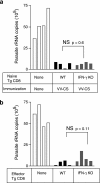Effector CD8+ T lymphocytes against liver stages of Plasmodium yoelii do not require gamma interferon for antiparasite activity
- PMID: 18519561
- PMCID: PMC2493192
- DOI: 10.1128/IAI.00471-08
Effector CD8+ T lymphocytes against liver stages of Plasmodium yoelii do not require gamma interferon for antiparasite activity
Abstract
The protective immune response against liver stages of the malaria parasite critically requires CD8(+) T cells. Although the nature of the effector mechanism utilized by these cells to repress parasite development remains unclear, a critical role for gamma interferon (IFN-gamma) has been widely assumed based on circumstantial evidence. However, the requirement for CD8(+) T-cell-mediated IFN-gamma production in protective immunity to this pathogen has not been directly tested. In this report, we use an adoptive transfer strategy with circumsporozoite (CS) protein-specific transgenic T cells to examine the role of CD8(+) T-cell-derived IFN-gamma production in Plasmodium yoelii-infected mice. We show that despite a marginal reduction in the expansion of naive IFN-gamma-deficient CS-specific transgenic T cells, their antiparasite activity remains intact. Further, adoptively transferred IFN-gamma-deficient CD8(+) T cells were as efficient as their wild-type counterparts in limiting parasite growth in naive mice. Taken together, these studies demonstrate that IFN-gamma secretion by CS-specific CD8(+) T cells is not essential to protect mice against live sporozoite challenge.
Figures


References
-
- Bruna-Romero, O., J. C. Hafalla, G. Gonzalez-Aseguinolaza, G. Sano, M. Tsuji, and F. Zavala. 2001. Detection of malaria liver-stages in mice infected through the bite of a single Anopheles mosquito using a highly sensitive real-time PCR. Int. J. Parasitol. 311499-1502. - PubMed
-
- Carvalho, L. H., J. C. Hafalla, and F. Zavala. 2001. ELISPOT assay to measure antigen-specific murine CD8+ T-cell responses. J. Immunol. Methods 252207-218. - PubMed
-
- Chakravarty, S., I. A. Cockburn, S. Kuk, M. G. Overstreet, J. B. Sacci, and F. Zavala. 2007. CD8+ T lymphocytes protective against malaria liver stages are primed in skin-draining lymph nodes. Nat. Med. 131035-1041. - PubMed
-
- Del Giudice, G., D. Grillot, L. Renia, I. Muller, G. Corradin, J. A. Louis, D. Mazier, and P. H. Lambert. 1990. Peptide-primed CD4+ cells and malaria sporozoites. Immunol. Lett. 2559-63. - PubMed
-
- Doolan, D. L., and S. L. Hoffman. 2000. The complexity of protective immunity against liver-stage malaria. J. Immunol. 1651453-1462. - PubMed
Publication types
MeSH terms
Substances
Grants and funding
LinkOut - more resources
Full Text Sources
Research Materials

